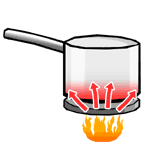Cooling 101: The Basics of Heat Transfer
Moving Heat
As the First Law of Thermodynamics implies, matter and energy can not be created or destroyed (only converted between the two). Likewise, heat--the movement of energy from a hotter object to a cooler object--is never eliminated, but only moved elsewhere. This is the role of all cooling systems.
To accomplish this, there are three primary modes of heat transfer. Some forms of transfer can be duplicated using multiple methods (both natural and forced), but every cooling system uses these same basic processes:
-
 Conduction - the transfer of heat through matter with no net displacement of the matter
Conduction - the transfer of heat through matter with no net displacement of the matter -
 Convection - the circulatory motion of a gas or liquid caused by the variation of its density and the action of gravity
Convection - the circulatory motion of a gas or liquid caused by the variation of its density and the action of gravity -
 Radiation - the process of transferring heat by emitting electromagnetic energy in the form of waves or particles
Radiation - the process of transferring heat by emitting electromagnetic energy in the form of waves or particles
Thermal Conductivity
Thermal Conductivity is the amount of heat a particular substance can carry through it in unit time. Usually expressed in W/(mK), the units represent how many Watts of heat can be conducted through a one meter thickness of said material with a one Kelvin temperature difference between the two ends.
(Note: "Thermal Conductivity" is the measure of heat flowing through a length, not to be confused with "Thermal Conductance", which is the measure of heat though a surface.)
Specific Heat Capacity
Specific Heat Capacity is the amount of heat a particular substance can hold. Typically expressed in KJ/(kgK), the rate depicts how many kilojoules of energy are required to change the temperature of one kilogram of said substance by one Kelvin.
What do all of these numbers mean in a liquid cooling system?
The above thermal conductivity shows why copper is the preferred cold plate material for cooling systems. It is extremely close to silver in performance at a fraction of the cost. Like most metals however, copper doesn't hold heat for very long-- it needs to be absorbed by something else.
The specific heat capacities show water to be the best liquid for holding heat. Practically, it is also the best for transferring it.
This would indicate the ideal configuration is to use copper to transfer heat from the processor, and to use water to absorb and move away the heat. Although there are many other factors involved, here you have the basic foundation of a liquid cooling system.

Stay Connected